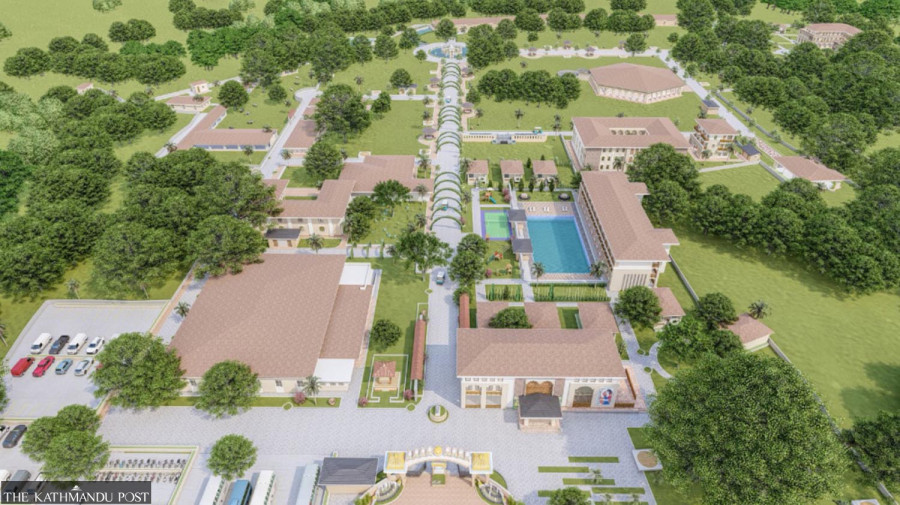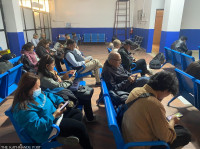Money
Janak Dham: A marketplace of godly goods
Two brothers in Janakpur, the birthplace of Sita, have devised a unique project to explain religion’s support for the economy.
Ajit Tiwari
In August 2014, Indian Prime Minister Narendra Modi visited the Pashupatinath Temple, a significant temple of the Hindu god Shiva.
In May 2018, he visited Janakpur, the famous Hindu pilgrimage site. In May 2022, he visited Lumbini, the birthplace of Lord Buddha.
His visit drew thousands of Indian visitors, particularly for pilgrimage purposes.
Nepal has been a centre for Hindu and Buddhist pilgrims. It is considered the dwelling place of Lord Shiva and the birthplace of Buddha and Goddess Sita.
A fraction of tourists visit Nepal for religious purposes, but Nepal has never realised the potential of spiritual products that have not been branded, marketed, and promoted.
Various studies have shown that religion has become a niche product in a society overrun by commercial clutter, and it could boost the economy.
Now, two brothers in Janakpur, in Nepal’s southern plain, the birthplace of Sita, have devised a unique project: The construction of Janak Dham.
“The work has already started. The Dham will be spread over 22 bigas (148,998 square meters) in Chhireshwarnath Municipality-8, Dhanusha,” said Kausalendra Jha, a chartered accountant.
“The project costs Rs2 billion, and it looks like a palace of King Janak. The five-year project plans to produce, promote and market religious goods and services, the first of its kind in Nepal,” said Kausalendra, who has his brother Ragvendra Jha, a hotel entrepreneur, as his investment partner.
Currently, 100 cows are kept in Janak Dham. The Jha brothers plan to commercially sell more than a dozen products made from cow’s milk, including urine and dung.
Under the project, agriculture and industry based on cows will be built, an Ayurveda and natural hospital, a meditation and Janak Darshan Centre, a convention hall with the capacity for 1,000 people, a resort, a children's park, and an audio-video hall will be established.
Pilgrimage tourism has a higher scope in Nepal. Since Nepal has become a key gateway for the Kailash Mansarovar Yatra in Tibet, China, developing and marketing religious products could primarily benefit the local economy.
Annually, 40,000 to 50,000 Indians visited Tibet using Nepal’s route before the Covid-19 pandemic.
Lumbini used to host nearly 1.5 million visitors, including Nepalis, before the Covid and is now gradually recovering.
In 2023, about 1.2 million people visited Lumbini, especially with a significant influx of 70,000 Indian tourists. Annually, millions visit Pashupatinath temple in Kathmandu.
“We also plan to sell the products through our outlets in Sankhamul, Kathmandu and Janaki temple, Janakpur,” said Kausalendra.
The construction of Janak Dham is expected to be over in five phases. The first phase has almost been completed, and cow-based agriculture and industry have already started.
Preparations are ready to introduce 12 products of Janak Dham to the markets of Kathmandu and Janakpur in the first phase.
Kausalendra said buttermilk, takrarishta, a traditional Ayurvedic fermented buttermilk, and five varieties of ghee, including one that can be put in the nose, will be produced.
Similarly, the Dham will produce colostrum, sugar-free sweets, paneer, incense sticks, gomutra ark, a distilled form of cow urine and punarnava ark, an Ayurvedic medicine used in the treatment of jaundice, anaemia, abdominal diseases, diabetes and bleeding disorders.
It will also produce organic fertiliser, jackfruit flour, kolhu edible oil, and food grains prepared traditionally.
“All our products are made with cow’s milk, urine and dung. Made from A2 milk, which contains lactose and is chock-full of key nutrients like protein and calcium, all our production has Ayurvedic characteristics,” said Kausalendra.
He said that as the production of Janak Dham is limited, it is currently targeted at two cities.
The Dham started with 100 cows of different breeds, such as hariyana, sahibal, gir, and achhami, and plans to increase the number of cows by 400.
“Madhesh is the foodgrain basket. However, the application of toxic pesticides has been impacting people’s health. The food grains nurtured by cow dung fertiliser are healthy,” Kausalendra said.
The farmer of Digambarpur, where the Dham is located, has started using organic manure.
Kausalendra, who worked for a long time in agriculture projects under the World Bank, said they decided to change their lifestyle during the Covid-19 period.
So, the Jha brothers decided during a coronavirus lockdown to make Janak Dham.
“We do not need to bring raw material from other places to produce our goods. Everything is produced here,” they said. “We plan to introduce our products to the elite class in the initial phase. The production will be increased based on the demand.”




 8.12°C Kathmandu
8.12°C Kathmandu













